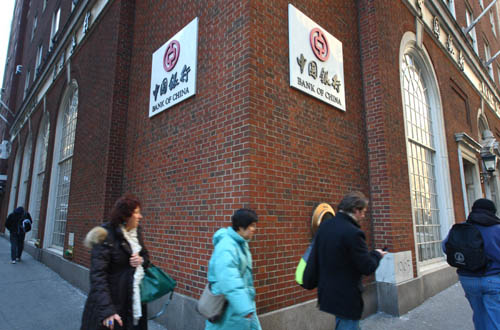|
 |
|
The New York branch of the Bank of China. Standard &Poor's said the global push of Chinese banks won't affect their ratings over the next two to three years. [Photo/Xinhua] |
Lending institutions' expansions overseas won't affect ratings
Large Chinese banks' balance sheets remain strong despite their rapid international expansion in recent years, the credit rating agency Standard & Poor's said on Thursday.
In a report published in Hong Kong, the agency said the banks' global push won't affect their ratings over the next two to three years, though some lenders' profitability might be hurt in the domestic market due to escalating competition.
China's Big Four State-owned banks, Industrial and Commercial Bank of China Ltd, China Construction Bank Corp, Agricultural Bank of China Ltd and Bank of China Ltd, are rated in the top class of ratings by the agency.
Generally, aggressive overseas expansion increases a bank's risk exposure by subjecting it to swings in the overseas market, though it will benefit in the long run.
The agency sees it as "an unlikely scenario" that Chinese banks will be substantially affected by overseas markets.
Part of the reason is that Chinese banks mostly expand through organic growth rather than acquisitions and, despite their fast growth, their overseas assets remains low as a percentage of their total assets, at below 10 percent.
Chinese banks started to venture overseas in recent years, following in the footsteps of other Chinese companies, whose growing overseas operations created huge demand for financial services.
Overseas investment and acquisitions by Chinese companies more than doubled to $380 billion at the end of 2011 from $170 billion at the end of 2008.
Chinese banks currently have 1,148 overseas branches in Asia, Europe, the Middle East and the Americas, up 29 percent from 2010.
Their overseas assets have also increased rapidly. Industrial and Commercial Bank of China, the nation's biggest lender, has seen its offshore assets increase at an average annual rate of 39 percent since 2010.
Hong Kong, given its status as the world's biggest yuan center, serves as a springboard for mainland banks' global push. China's five biggest banks currently have 42 percent of their overseas assets in Hong Kong.
Jin Lin, a banking industry analyst with Orient Securities Co Ltd, said that Chinese banks' global push, at its current stage, is unlikely to damage their balance sheets.
"The expansion is fast but also with a measure of prudence. I don't think their overseas operations could damage their overall profitability," said Jin.
However, some Chinese banks could be squeezed in the domestic market, as the central bank's moves toward interest rate liberalization encourage competition and the country's economic growth concentrates more on quality than quantity.
S&P said in its report that it estimates that the People's Bank of China's decisions earlier this year to allow deposit rates to rise to 110 percent of the benchmark rate and the lending rate to fall to 70 percent of the benchmark rate will cut the banking sector's average return on assets this year by 10 basis points, or $17 billion, and by 20 to 25 basis points, or $42 billion, in 2013.
As a result, a market consolidation will take place in which large lenders take over smaller players felled by escalating competition.
gaochangxin@chinadaily.com.cn
